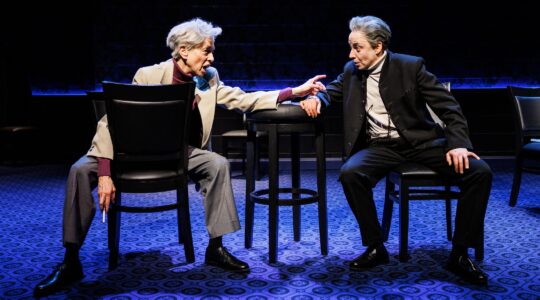‘Clothes make the man,” said Mark Twain. “Naked people have little to no influence on society.” But when it comes to the media, there’s little other than clothes that can justify calling Chabad “ultra-Orthodox,” and even at that, they dress in ways that would fit in at Yeshiva University.
Chabad, one could argue, are really “Modern Orthodox,” having pioneered the use of the Internet in the Orthodox community; giving equal status to women, alongside men, as the rebbe’s emissaries; being tolerant and inclusive, offering their services to secular and non-Orthodox Jews; and supporting Israeli troops.
Yet, dozens of newspapers insisted on describing Rabbi Gavriel and Rivkah Holtzberg, martyrs of the Mumbai attacks, as “ultra-Orthodox.”
Mark Steyn, writing in the National Review
and Washington Times (Dec. 6), noted that “ultra” was used “in almost all the western media … less a term of theological precision than a generalized code for ‘strange, weird people, nothing against them personally, but.” And Steyn adds, were these ultras “stranger or weirder than their killers?”
The Islamic killers were rarely labeled Muslims but rather “gunmen,” “militants” or “terrorists.” In The New York Times coverage of the turmoil in Hebron (Dec. 5), we’re told in the very first sentence, and in some headlines, the rioters were “hard-line Jewish settlers.” The Times would never go a whole story about rioting settlers and not call them Jewish but “militants,” but where is the paper, anywhere, that seeks to inoculate Judaism from its extremists, a courtesy so often extended to Islam?
Criticism of the Mumbai coverage has been coming from both right and left. In The Huffington Post, Marshall Herskovitz (Dec. 3) accused the media of burying the news that doctors said the Jews killed in Mumbai “bore the maximum torture marks. … It was so bad that I do not want to go over the details even in my head again.”
Herskovitz writes, “Horrifying. And mystifying — because this news item, carried around the world, has been utterly absent from the mainstream U.S. media. Other than The Huffington Post and The Drudge Report (unusual bedfellows indeed), you cannot find this report anywhere on CNN, CBS, ABC, FOX, The New York Times, LA Times, Washington Post — nowhere. Why? I have no idea. Is this not news? …. I cannot escape the feeling that — for whatever reasons … this lack of coverage (or even curiosity about the story) is absolutely intentional.”
The original torture story appeared in India’s Rediff (Nov. 30), one of India’s top five Web portals. The New York Daily News had it on Dec. 4. The Times of London picked it up, telling its readers (Dec. 6), “there are indications that the six who died inside [the Chabad house] were bound and tortured.” The Times of India (Dec. 1) reported that an Israeli forensic team had to use “DNA testing and dental records to identify bodies so mutilated they could ‘not be identified from their faces.’”
The report is incomplete; some suggested that the mutilation could have come from shooting or grenades, not torture. But considering how much of the American media’s coverage was based on preliminary and conflicting information of far less substance and implication, the reluctance to follow the London Times and at least report on “the indications” seems inexplicable. The U.S. media has been known to publish far more on other stories that are based on far less.
Sanitizing of the Jewish angle, let alone Jewish-Islamic relations in Mumbai, was rampant, even by Mumbai’s Jewish leaders. “This is the first time when a Jew has been targeted in India because he is a Jew,” the president of the Indian Jewish Federation told the Times (Dec. 3). Another Jew, chairman of several Mumbai Jewish institutions, said Muslims “live with us as brothers and in brotherhood.”
The Times concludes, “Historically, relations between [Jews and Muslims] in Mumbai have been good.”
Historically, that’s not correct, according to The New York Times itself. On Feb. 17, 1991, the Times reported Mumbai’s Jews were “a very vulnerable minority” in Muslim neighborhoods “where posters of President Saddam Hussein of Iraq are sold.” There was fear among Mumbai Jews that events “could turn neighbors against them in a country where decades of official support for the Palestine Liberation Organization has contributed to the creation of a climate generally hostile to Israel.”
That sounds more ominous than the current claims that all was well until November.
The Times does not quote any Muslim leaders or Muslims or Hindu street people to verify the brotherhood claims of Jewish leaders, but other papers do (mostly outside the U.S.), and it’s not the spin that Mumbai’s Jewish leaders would have you believe. The London Times (Nov. 27) quotes T. K. Bhat, who lives close to the Chabad house: “It could be that the attitudes of the Chabad, which gives the sense of an elite club for Jews alone, is part of what provoked the terrorists to target them for the attack.”
Agence France-Press (Dec. 9) quotes Ahmad Khan, a neighbor of the Mumbai Chabad, saying he did not believe official accounts that the Chabad had been attacked by Muslim terrorists: “They [the Jews] were here for two or three years, we don’t know who attacked them, if it was the Jews themselves using their own arms to fight the police, or others. This is their own house, they can come back and live in it if they want, but I won’t feel safe,” forget how the Jews will feel.
Radio talk show host Dennis Prager (Dec. 3) wrote, “Imagine a Basque separatist terrorist organization attacking Madrid. Would the terrorists take time out to murder all those in the Madrid Chabad House? The idea is ludicrous. But no one seems to find it odd that that Pakistani Muslim terrorists who hate India and want it to give up control of Indian Kashmir would send two of its 10 terrorists to kill perhaps the only rabbi in Mumbai,” while not touching any Hindu site.
In Haaretz (Dec. 3), Bradley Burston wrote, “For the whole of my adult life, it irked me when [people would] accuse anti-Zionists of being anti-Semitic, and conflate anti-Israeli sentiment with the Nazis. … Only this week did I realize my error. It turns out that when Jews suspected that the jihadi hated the Jew the way the Nazi hated the Jew, they were right. After all this time, I am embarrassed to admit that only when the monsters entered Chabad House in Mumbai, did I understand.
“Monsters,” writes Burston, “not solely for what they did there, but, if the reports are to be believed, for the fact that they were able to do what they did after having actually gotten to know the young couple who founded the center, after asking them for shelter in Chabad House, after telling them that they were Malaysian students eager to learn about Judaism. Monsters, for having befriended these sweet people in order to better learn how to execute them….”
Solomon, the Mumbai Jewish leader, told the Associated Press, “The gunmen were likely drawn to their target by their anger with Israel, rather than any conflict with the local Jewish community.” But Burston argues that the jihadist’s “hatred of the Jew is such that even if a Jew rejects the concept of a State of Israel and is wholeheartedly opposed to Zionism, if he wears the clothing of a believing Jew — as in the case of victim Aryeh Leibish Teitelbaum — he will be bound and tortured and put to death.” All Jews were marked for death: religious, secular, Zionist, non-Zionist.
“One lesson of the Holocaust,” writes Burston, “is that one can’t afford to miss the signs and the intentions. … I’m only seeing it now.”
The New York Jewish Week brings you the stories behind the headlines, keeping you connected to Jewish life in New York. Help sustain the reporting you trust by donating today.




